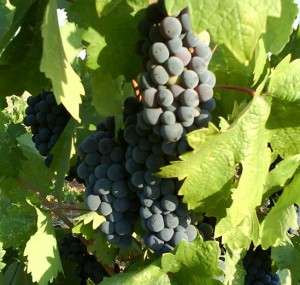
Zinfandel Grapes. The image is believed to be in the public domain.
Oh, man, there are times when I read something really phenomenal about a subject I’m knowledgeable about and think, “Man, I wish I’d written this”. Well, today I had just that experience.
Patrick Frank, one of the writers at Palate Press, wrote a great piece about the old growth Zinfandel vines in Amador County that was published there today. He provides a wonderful history of these vines, how and why Zinfandel vines ended up in Amador County and recounts how these vines have survived for 140+ years. Go read it. Really. I’ll wait.
Read it? Good.
There are many small vineyards in Gold Country with old growth Zinfandel vines dating from the 1860’s – 1880’s. Some Gold Country wineries feature wines made from these. I’ve tasted wines from these vines made by Deaver and Vino Nocento and others.
There are also wineries that feature wines made from plants that have grafts from the old growth vines on modern root stock. I’m sure I’ve had some of these as well. Though, they are labeled as being from “grandpere” vines, personally, I don’t think they count.
And, what, you may be asking yourself, makes wines made from grapes from old vines so special? Well, it’s the flavor. When you encounter wines made from old growth grapes, the flavor just blows away that made from younger vines. The flavors are richer, more intense and more complex.
This is because the yield from old vines is lower. There are fewer grapes per vine. This means less wine can be made than from a similar number of younger vines. But that means that all the energy and flavors get deposited in a fewer number of grapes. It is almost like the grapes have been supercharged with flavors.
I also believe that there is a more complex flavor profile. While the grapes are more intensely “Zinfandel” because of the concentrated flavors, similar affects can be created when vintners restrict the yield by cutting off some grape bunches early on. But in the case of older vines, you get the added benefits of 140+ years of roots digging deep into the soil tapping into layers of geological goodness and dragging that up into the grapes. This is where you can really taste the terroir, the essence of the place, which can only be hinted at in vines planted in the last 10 to 20 years.
If wines from old growth vines are so phenomenal, and they are, why don’t wineries leave their vines in place and let them get old? Why do some wineries regularly pull out vines that are 25 years old or older? Economics, my friend. Economics. Older vines don’t produce as many grapes. This makes for great wines, but it means wineries can’t necessarily produce the volume of wines necessary to make a living.
Often times the old vines are grapes that no longer appeal to modern tastes. Mission grapes, for instance. The Catholic missionaries brought vine cuttings with them to the new world. They early settled on a variety, probably Spanish in origin, that has come to be known as Mission. This vine is extraordinarily hearty and can produce wine grapes in a wide range of climates. This allowed the Missionaries to produce wine for Communion services pretty much wherever they landed. But the wine is fussy and not great for drinking. Most of the Mission vineyards were pulled out if not 100+ years ago, surely after the repeal of Prohibition, making room for Zinfandel, Barbera, Cabernet Sauvignon and all the other wines that suit our modern palates better.
Gold Country has more of these old growth vineyards than many grape growing regions, including not only Zinfandel, but also Mission. So when you are up in the area, keep an eye out and jump at the chance to taste history!
Related Posts :
Vines surrounding Gold Hill Vineya ...
Let me start off the New Year with a "Drink Now Alert!" Last night our neighbors served us a 20 ...
View of the vineyard at Mastroseri ...



BUT the mission vines are excellent for making Ports. Try Deaver’s Golden Nectar or Angelica Ports, they’re outstanding!! And these mission vines are over 150 years old!